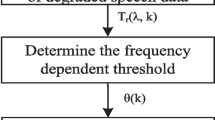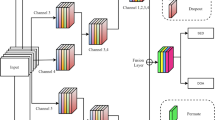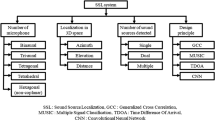Abstract
This paper presents a nonlinear-acoustic-echo-cancellation (NAEC) technique to tackle sigmoid-type nonlinearities under noisy environment. The nonlinear echo in acoustic systems is inevitable due to the inherent nonlinear characteristics of amplifiers and/or loudspeakers, which deteriorates the quality of speech as well as audio signal reception. Here, the sigmoid-type nonlinearity is modelled by incorporating two control parameters, which determine the shaping- and clipping-parameter values of the saturation curve at a particular room temperature. These control parameters are adjusted by utilizing the variable-step-size (VSS) least-mean-square (LMS) algorithm to enhance the convergence rate and tracking capability of presented NAEC. Furthermore, the impulse response of a room (indoor channel) in the acoustic echo path is modelled as a tap-delay-line finite-impulse-response filter, whose tap-coefficients are estimated by utilizing a modified recursive-least-squares (RLS) algorithm (involving the noise statistics) at the different values of signal-to-noise-ratio (SNR), when correlated as well as uncorrelated input signals are processed. Simulation results demonstrate the efficiency and efficacy of above mentioned adaptive NAEC technique using the VSS-LMS and modified RLS algorithms in terms of the high convergence rate as well as high value of echo-return-loss-enhancement (ERLE) factor. Both the elevating value of shaping-parameter (i.e., increasing nonlinearity level) and the alleviating value of SNR adversely affect the performance of all NAECs. However, the VSS-LMS and modified RLS algorithm based presented adaptive NAEC outperforms the traditional VSS-LMS and normalized-least-mean-square (NLMS) algorithm based NAEC under similar conditions.







Similar content being viewed by others
References
Nollett, B.S., & Jones D.L. (1997). Nonlinear echo cancellation for hands-free speakerphones. In Proc. IEEE Workshop Nonlinear Signal Image Process. (NSIP), Mackinac Island, MI (pp. 1–5).
Fu, J., & Zhu, W.-P. (2008). A nonlinear acoustic echo canceller using sigmoid transform in conjunction with RLS algorithm. IEEE Transactions on Circuits and Systems II: Express Briefs, 55(10), 1056–1060.
Ahgren, P. (2005). Acoustic echo cancellation and doubletalk detection using estimated loudspeaker impulse. IEEE Transactions on Speech and Audio Processing, 13(6), 1231–1237.
Costa, J.-P., Lagrange, A., Arliaud, A. (2003). Acoustic echo cancellation using nonlinear cascade filters. In Proc. ICASSP, vol. 5, Hong Kong, China (pp. 389–392).
Guerin, A., Faucon, G., & Bouquin-Jeannes, R. L. (2003). Nonlinear acoustic echo cancellation based on Volterra filters. IEEE Transactions on Speech and Audio Processing, 11(6), 672–683.
Kuech, F., & Kellermann, W. (2004). Partitioned block frequency-domain adaptive second-order Volterra filter. IEEE Transactions on Signal Processing, 53(2), 564–575.
Kuech, F., Mitnacht, A., Kellermann, W. (2005). Nonlinear acoustic echo cancellation using adaptive orthogonalized power filters. In Proc. IEEE ICASSP, vol. 3, Philadelphia, PA (pp. 105–108).
Panicker, T. M., & Mathews, V. J. (1998). Parallel-cascade realizations and approximations of truncated Volterra systems. IEEE Transactions on Signal Processing, 46(10), 2829–2832.
Sentoni, G., & Altenberg, A. (2005). Nonlinear acoustic echo canceller with DABNET + FIR structure. In Proc. IEEE Workshop on Applications of Signal Processing to Audio and Acoustics, New Paltz, NY, USA (pp. 37–40).
Stenger, A., Trautmann, L., Rabenstein, R. (1999). Nonlinear acoustic echo cancellation with 2nd order adaptive Volterra filters. In Proc. IEEE ICASSP, vol. 2, Phoenix, USA (pp. 877–880).
Stenger, A., & Rabenstein, R. (1999). Adaptation of acoustic echo cancellers incorporation a memoryless nonlinearity. In Proc. IEEE IWAENC, Pocono Manor, PA (pp. 168 – 171).
Stenger, A., & Kellermann, W. (2000). Nonlinear acoustic echo cancellation with fast converging memoryless pre-processor. In Proc. International Conference on Acoustics, Speech, and Signal Processing. (ICASSP), vol. 2, Istanbul, Turkey (pp. II805–II808).
Comminiello, D., Scarpiniti, M., Azpicueta-Ruiz, L. A., Garcia, J. A., & Uncini, A. (2013). Functional link adaptive filters for nonlinear acoustic echo cancellation. IEEE Transactions on Audio, Speech and Language Processing, 21(7), 1502–1512.
Vaerenbergh, S.V., & Azpicueta-Ruiz, L.A. (2014). Kernel-based identification of Hammerstein systems for nonlinear acoustic echo cancellation. In Proc. IEEE ICASSP, vol. 1, Florence, Italy (pp. 3739–3743).
Rai, A., & Kohli, A. K. (2015). Volterra filtering scheme using generalized variable step-size NLMS algorithm for nonlinear acoustic echo cancellation. Acta Acustica United with Acustica, 101(4), 821–828.
Rai, A., & Kohli, A. K. (2014). Adaptive polynomial filtering using generalized variable step-size pth power (LMP) algorithm. Circuits, Systems and Signal Processing, 33(12), 3931–3947.
Hamidia, M., & Amrouche A. (2019). Improving acoustic echo cancellation in hands-free communication systems. In Proc. ISPA, vol. 1, Mostaganem, Algeria (pp. 1–5).
Dai, H., & Zhu, W.-P. (2006). Compensation of loudspeaker nonlinearity in acoustic echo cancellation using raised-cosine function. IEEE Transactions on Circuits and Systems II: Express Briefs, 53(11), 1190–1194.
Breining, C., Dreiscitel, P., Hansler, E., Mader, A., Nitsch, B., Puder, H., et al. (1999). Acoustic echo control: an application of very-high-order adaptive filters. IEEE Signal Processing Magazine, 16(4), 42–69.
Paleologu, C., Ciochina, S., & Benesty, J. (2008). Variable step-size NLMS algorithm for under-modeling acoustic echo cancellation. IEEE Signal Processing Letters, 15, 5–8.
Kohli, A. K., & Mehra, D. K. (2006). Tracking of time-varying channels using two-step LMS-type adaptive algorithm. IEEE Transactions on Signal Processing, 54(7), 2606–2615.
Garg, H. K., & Kohli, A. K. (2017). Excision of ocular artifacts from EEG using NVFF-RLS adaptive algorithm. Circuits, Systems and Signal Processing, 36(1), 404–419.
Diniz, P. S. R. (2002). Adaptive filtering (2nd ed.). Norwell: Kluwer.
Lee, K., Baek, Y., & Park, Y. (2015). Nonlinear acoustic echo cancellation using a nonlinear postprocessor with a linearly constrained affine projection algorithm. IEEE Transactions on Circuits and Systems II: Express Briefs, 62(9), 881–885.
Kuhn, E. V., Kolodziej, J. E., & Seara, R. (2014). Stochastic modeling of the NLMS algorithm for complex Gaussian input data and nonstationary environment. Digital Signal Processing, 30, 55–66.
Elko, G.W., Diethorn, E., Gansler, T. (2003). Room impulse response variation due to thermal fluctuation and its impact on acoustic echo cancellation. In Proc. IEEE IWAENC, Kyoto, Japan (pp. 67–70).
Haykin, S. (1999). Neural networks (2nd ed.). Prentice-Hall: Pearson Education.
Aboulnasr, T., & Mayyas, K. (1997). A robust variable step-size LMS-type algorithm: analysis and simulations. IEEE Transactions on Signal Processing, 45(3), 631–639.
Haykin, S. (1996). Adaptive filter theory (3rd ed.). Prentice-Hall: Englewood Cliffs.
Kwong, R. H., & Johnston, E. W. (1992). A variable step size LMS algorithm. IEEE Transactions on Signal Processing, 40(7), 1633–1642.
Kohli, A. K., Rai, A., & Patel, M. K. (2011). Variable forgetting factor LS algorithm for polynomial channel model. ISRN Signal Processing, 915259, 1–4.
Kohli, A. K., & Rai, A. (2013). Numeric variable forgetting factor RLS algorithm for second-order Volterra filtering. Circuits, System and Signal Processing, 32(1), 223–232.
Zhang, H., Tan, K., Wang, D. (2019). Deep learning for joint acoustic echo and noise cancellation with nonlinear distortions. In Proc. INTERSPEECH, vol. 1, Graz, Austria (pp. 15–19).
Widrow, B., McCool, J. M., Larimore, M. G., & Johnson, C. R. (1976). Stationary and nonstationary learning characteristics of LMS adaptive filter. Proceedings of the IEEE, 64(8), 1151–1162.
Song, S., Lim, J. S., Baek, S. J., & Sung, K. M. (2002). Variable forgetting factor linear least squares algorithm for frequency selective fading channel estimation. IEEE Transactions on Vehicular Technology, 51(3), 613–616.
Sunitha, T., & Malar, R. S. M. (2018). Nonlinear acoustic echo cancellation based on multichannel adaptive filters: a novel approach. Wireless Personal Communications, 102(4), 3269–3284.
Papoulis, A. (1991). Probability random variables and stochastic processes (3rd ed.). New York: McGraw-Hill.
Kapoor, D. S., & Kohli, A. K. (2015). Simulation of basis expansion model for channel fading using AR1 process. Wireless Personal Communications, 85(3), 791–798.
Singh, S., & Kohli, A. K. (2014). Wireless fading paradigm for antenna array receiver for a disk-type cluster of scatterers. Circuits, Systems and Signal Processing, 33(4), 1231–1244.
Sukhumalwong, S., & Benjangkaprasert, C. (2006). Adaptive echo cancellation using variable step-size algorithm lattice filters. In Proceeding of IEEE TENCON Region 10 Conference, Hong Kong, China (pp. 1–4).
Kapoor, D. S., & Kohli, A. K. (2018). Channel estimation and long-range prediction of fast fading channels for adaptive OFDM system. International Journal of Electronics, 105(9), 1451–1466.
Halimeh, M. M., Huemmer, C., & Kellermann, W. (2019). A neural network-based nonlinear acoustic echo canceller. IEEE Signal Processing Letters, 26(12), 1827–1831.
Author information
Authors and Affiliations
Corresponding author
Additional information
Publisher's Note
Springer Nature remains neutral with regard to jurisdictional claims in published maps and institutional affiliations.
Rights and permissions
About this article
Cite this article
Kohli, A.K., Sharma, J. Nonlinear Acoustic Echo Canceller to Combat Sigmoid-Type Nonlinearities Under Noisy Environment. Wireless Pers Commun 114, 3489–3506 (2020). https://doi.org/10.1007/s11277-020-07544-3
Published:
Issue Date:
DOI: https://doi.org/10.1007/s11277-020-07544-3




